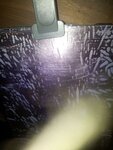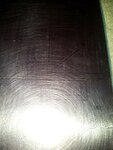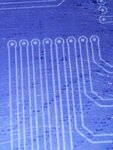boylesg
Advanced Member level 4

- Joined
- Jul 15, 2012
- Messages
- 1,023
- Helped
- 5
- Reputation
- 10
- Reaction score
- 6
- Trophy points
- 1,318
- Location
- Epping, Victoria, Australia
- Activity points
- 11,697
In another life I was a medical scientists and experienced with preparing 6 micron paraffin sections of human and animal tissue for staining and examination under a microscope.

I became extremely frustrated with trying to apply UV film using a laminator.
The problem was it was impossible to avoid wrinkles, bubbles and dust between the film and the copper.
And as soon as you develop the exposed UV film the polymer detaches from the copper where ever it was not in direct contact due to air, dust or wrinkles thus leaving missing chunks from traces etc.
However it occurred to me later that I could try a similar technique for applying the film to the copper as used to adhere very thin paraffin sections to glass microscope slides. In the latter case the water is warm enough to soften but not melt the paraffin wax and the surface tension of the water flattens the paraffin sections out perfectly allowing them to be picked up on a microscope slide from the water surface perfectly flat.
The only difference with UV film is that the water can be cold.
What you do is submerge the copper clad and then peel off the first plastic covering while it is in the water.
The UV film flattens out nicely, does not stick to itself and does not roll up.
You then use a similar technique to pick the UV film up with the copper clad.
There will be more than desirable water under the film but most of it can be squeezed out with a roller without introducing air.
Then you need to allow this to dry - the oven on 50 degrees or so works well or in front of a heater. Even so I suggest you leave it over night.
As the water evaporates away it creates a vacuum that 'sucks' the film tightly on to the copper clad.
Here are some photos (deliberately large so that you can closely examine the surfaces if you wish):

This shows a copper clad still in the process of drying - water makes the film opaque.

This shows a fully dried copper clad - a laminator was not used to make this.

This is the result exposing and developing the the copper clad.
I am also trying this technique with Press'n'Peel which suffers the same problem.
I also tried this technique with metho rather than water due to its lower boiling point....but don't bother because it dissolves the UV sensitive polymer.

I became extremely frustrated with trying to apply UV film using a laminator.
The problem was it was impossible to avoid wrinkles, bubbles and dust between the film and the copper.
And as soon as you develop the exposed UV film the polymer detaches from the copper where ever it was not in direct contact due to air, dust or wrinkles thus leaving missing chunks from traces etc.
However it occurred to me later that I could try a similar technique for applying the film to the copper as used to adhere very thin paraffin sections to glass microscope slides. In the latter case the water is warm enough to soften but not melt the paraffin wax and the surface tension of the water flattens the paraffin sections out perfectly allowing them to be picked up on a microscope slide from the water surface perfectly flat.
The only difference with UV film is that the water can be cold.
What you do is submerge the copper clad and then peel off the first plastic covering while it is in the water.
The UV film flattens out nicely, does not stick to itself and does not roll up.
You then use a similar technique to pick the UV film up with the copper clad.
There will be more than desirable water under the film but most of it can be squeezed out with a roller without introducing air.
Then you need to allow this to dry - the oven on 50 degrees or so works well or in front of a heater. Even so I suggest you leave it over night.
As the water evaporates away it creates a vacuum that 'sucks' the film tightly on to the copper clad.
Here are some photos (deliberately large so that you can closely examine the surfaces if you wish):

This shows a copper clad still in the process of drying - water makes the film opaque.

This shows a fully dried copper clad - a laminator was not used to make this.

This is the result exposing and developing the the copper clad.
I am also trying this technique with Press'n'Peel which suffers the same problem.
I also tried this technique with metho rather than water due to its lower boiling point....but don't bother because it dissolves the UV sensitive polymer.